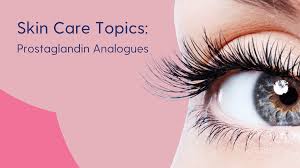
Prostaglandin Analogues for Lashes: Are They Safe?
Eyelash serums to grow eyelashes have become popular in recent years as a way to promote natural lash growth and volume. Many of these products, including Latisse, the only prescription lash treatment, contain a type of active ingredient called prostaglandin analogues. These ingredients were first used as a treatment for eye issues like glaucoma, which is how it was discovered that they also promote lash growth. Recently, there has been some discussion surrounding their potential side effects. Here, I explain the science behind how prostaglandins work, their safety, and which brands do and do not contain them.
Prostaglandin analogues promote natural eyelash growth and strength.
They can cause eye irritation and, in rare cases, change the color of your eyes.
There are some non-prostaglandin lash conditioners that use vitamins, peptides, and botanical ingredients instead.
These eyelash growers can cause a hollow eye look
How Do Prostaglandin Analogues Improve Lashes?
Prostaglandin analogues work by extending the growth phase (anagen phase) of the hair cycle. This results in longer, thicker, and darker lashes. Here’s a closer look at how they work:
Increasing blood flow to the area. This brings more nutrients but can cause redness.
Prolonging the anagen phase. The growth phase of eyelashes is naturally short. Prostaglandin analogues extend this growing phase, allowing lashes to grow longer than they typically would.
Increasing follicle size. These compounds can also increase the size of hair follicles, leading to thicker lashes.
Enhanced pigmentation. Prostaglandins can stimulate melanin production, making lashes appear darker. But this can also cause pigmentation around the eyes or change eye color.
Safety of Lash Growing Serums
Prostaglandin analogues have garnered some negative attention recently, as they can come with some side effects. The most known side effect of changing the color of your irises is rare unless the drops are used inside your eyes. It is more common to see darkening of the eyelid, redness around the eyes and loss of orbital fat resulting in sunken, hollow sunken eyes. Most people experience little to no side effects or only mild skin or eye irritation when using properly formulated lash serums.
The most notable side effects of prostaglandins include:
Eye irritation. Redness, itching, and discomfort commonly occur. You can reduce application to less frequently to lower this risk.
Eyelid skin darkening. Some people may notice increased pigmentation of the eyelid skin.
Eye color change: Rarely, prostaglandin analogues can cause permanent changes in iris color, particularly in individuals with light eyes.
Fat atrophy: In some cases, these compounds can lead to fat loss around the eye area, potentially causing a sunken appearance.
Eyelash abnormalities: Irregular lash growth, such as misdirected lashes, can also occur.
Styes: Some people who use lash serums report an increase in the development of styes.
Sunken Hollow Eyes Due to Orbital Fat Loss
Prostaglandin analogs, commonly used in lash serums for promoting eyelash growth, can lead to orbital fat loss, resulting in “hollow eyes” or “sunken eyes.” This condition, known as prostaglandin-associated periorbitopathy (PAP), occurs because these compounds can inhibit fat production and increase fat breakdown around the eyes. This loss of fat causes the eyes to appear more recessed and hollow, resulting in a sunken “tired eyes” appearance.
Which Lash Serums Contain Prostaglandin Analogues?
The majority of lash serums currently on the market contain prostaglandin analogues due to their proven effectiveness. Some of the most well-known include:
Latisse is the only prescription lash treatment FDA-approved for eyelash growth. It contains bimatoprost.
RevitaLash Advanced uses a blend of prostaglandin analogues to enhance lash length and thickness.
GrandeLASH-MD contains isopropyl cloprostenate, known for promoting lash growth.
If you aren’t concerned about prostaglandin analogues, here are some popular lash serum choices:
Which Lash Serums Do Not Contain Prostaglandins?
Some lash conditioners do not use prostaglandins to encourage lash growth. Instead, ingredients like biotin, keratin, vitamins, and botanicals can help to nourish eyelashes to make them appear healthier and fuller. A few leading brands that make a non-prostaglandin lash serum include:
Jane Iredale PureLash Lash Extender & Conditioner. This lash serum contains vitamin B5, algae extract, and stearic acid to strength, lengthen, and thicken lashes without the use of prostaglandins.
GrandeMASCARA Waterproof Conditioning Peptide Mascara uses a peptide called myristoyl pentapeptide-17 and vitamin E to condition and strengthen lashes and does not contain prostaglandin analogues.
Vichy LiftActiv Serum 10 for Eyes & Lashes helps lashes by using key ingredients such as rhamnose, glycerin, and hyaluronic acid to strengthen and condition them. This serum also targets the delicate skin around the eyes, providing anti-aging benefits while promoting healthier, more resilient lashes.
What Are Prostaglandin Analogues?
Prostaglandins are lipid compounds derived from fatty acids that perform hormone-like functions in the body. They play roles in various physiological processes, including inflammation, blood flow, and the induction of labor preceding childbirth. Prostaglandin analogues are synthetic versions of these compounds, designed to mimic their effects.
These compounds were initially developed and used in ophthalmology, particularly for the treatment of glaucoma. Patients using these medications for eye conditions began to notice a surprising side effect: longer, thicker, and darker eyelashes. This unexpected benefit spurred the development of cosmetic products containing prostaglandin analogues specifically for lash enhancement.
Examples of Prostaglandin Analogues
Prostaglandin analogues are used as prescription medications to treat glaucoma. Only Bimatoprost (Latisse) has proven efficacy and safety to grow lashes and is FDA approved for this purpose. However, other glaucoma medications also grow lashes but their safety and efficacy has not been formally studied. There are also botanical ingredients in cosmetic lash growers that also work like prostaglandin to grow lashes.
Prescription Prostaglandin Analogues
Several prostaglandin analogues are commonly found in lash serums:
Bimatoprost. Initially used to treat glaucoma, this analogue is now a key ingredient in Latisse, a popular lash growth serum. This is FDA approved and available only by prescription.
Isopropyl cloprostenate. Found in many over-the-counter lash serums, this ingredient is known for its lash-lengthening properties.
Latanoprost (Xalatan). Another prescription glaucoma drug that increases eyelash growth. It is not FDA approved for lash growth.
Tafluprost (Zioptan) is another glaucoma medication repurposed for cosmetic use in lash enhancers. It is available by prescription and is not FDA approved for lash growth.
Travoprost (Travatan and Travatan Z ) are prescription glaucoma medications that are not FDA approved to grow lashes.
Cosmetic Prostaglandin Analogues
There are many lash serums to grow lashes that you can get without a prescription. This does not mean they are safer. In fact, they are less studied than Latisse.
Synthetic Prostaglandin Analogues in Cosmetics
These peptides and botanicals are found in cosmetic lash growing serums. Because they are cosmetics and not drugs, trials looking at their safety and efficacy are sparse or nonexistent. However, there are many bestselling lash growing serums that use these ingredients.
Dechloro Dihydroxy Difluoro Ethylcloprostenolamide
Isopropyl Cloprostenate
Methylamido Dihydro Noralfaprostal
Norbimatoprost (very similar to bimatoprost)
Prostaglandin I2 (PGI2) Analogues
Prostaglandin F2α Analogues
Botanical Prostaglandin Analogues in Cosmetics
Caryodendron Orinocense Seed Oil: Derived from the cacay tree, it may have properties similar to prostaglandins.
Saw Palmetto Extract (Serenoa Repens): Known for its role in hair growth, some believe it might have prostaglandin-like effects.
Eclipta Prostrata Extract: Traditionally used in Ayurvedic medicine, this extract might have effects on hair growth that are similar to those of prostaglandins.
Ingredients That Grow Lashes That Are Not Prostaglandin Analogues
These peptides grow lashes but are not prostaglandin analogues so they do not have the same side effects as the prostaglandin analogues do.
Myristoyl Pentapeptide-17
Acetyl Tetrapeptide-3
Research Trials on Protaglandin Analogues
Many research trials have looked at the drug bimatoprost for eyelash growth. I was involved in one that showed that Latisse helped grow eyelashes in chemotherapy patients. (3)
These are the benefits of what bimatoprost does to lashes in clinical research trials:
Increase in anagen follicles
Fewer telogen follicles
Lengthening of individual eyelashes
Darker eyelash pigmentation
Thicker eyelashes
Vellus hair changes into medullated hair (thicker and darker)
Bottom Line
Prostaglandin analogues in lash serums can offer dramatic improvements in lash length, thickness, and darkness and are generally well tolerated by most people. However, side effects such as eye irritation, skin darkening, and, in rare cases, changes in eye color or fat loss around the eyes can occur. For personalized skin care advice based on your unique skin type, first take the skin type quiz, then consult with a dermatologist who can help you determine the best approach for achieving beautiful, healthy lashes.


